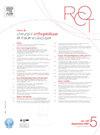Ostéotomie fémorale distale pour pathologie dégénérative du genou
Q4 Medicine
Revue de Chirurgie Orthopedique et Traumatologique
Pub Date : 2024-09-07
DOI:10.1016/j.rcot.2024.07.004
引用次数: 0
Abstract
Le membre inférieur est normoaxé avec un varus tibial et un valgus fémoral créant un interligne oblique en appui bipodal et horizontal en appui unipodal. Il peut être en valgus ou en varus en raison d’une déformation métaphysaire fémorale ou tibiale et fémorale. La correction osseuse doit être effectuée là où se situe la déformation. Si une déformation d’origine fémorale est corrigée au tibia, la correction est obtenue aux dépens d’une obliquité de l’interligne avec création d’un cal vicieux et un mauvais résultat fonctionnel. Dans le genu valgum, l’ostéotomie fémorale distale (fermeture médiale ou ouverture latérale) peut être indiquée en cas d’arthrose fémoro-tibiale latérale secondaire à une déformation extra-articulaire fémorale. Il en est de même dans le genu varum (fermeture latérale ou ouverture médiale) d’origine fémorale. La planification du geste est essentielle pour atteindre la cible idéale de correction, facteur essentiel de bon résultat. La technique chirurgicale est rigoureuse avec respect de la planification préétablie, réalisation d’une ostéotomie oblique idéalement biplanaire, correction précise et fixation stable par plaque verrouillée. Les complications sont liées à des erreurs techniques. La plus fréquente est l’erreur de correction (cal vicieux). La fracture de la charnière est également fréquente aggravant ces erreurs. Les guides sur mesure représentent la solution actuelle permettant d’améliorer la planification préopératoire, la précision chirurgicale ainsi que la protection de la charnière.
Niveau de preuve
Opinion d’expert.
The lower limb is normally aligned with tibial varus and femoral valgus, creating an oblique joint line in bipedal stance and a horizontal line in unipedal stance. Alignment may be valgus or varus due to femoral or combined tibial and femoral deformity. Bone correction must be performed at the site of the deformity. If a femoral deformity is corrected at the tibia, this leaves an oblique joint line and malunion, with poor functional outcome. In genu valgum, distal femoral osteotomy (either medial closing or lateral opening wedge) may be indicated in case of lateral femorotibial osteoarthritis secondary to extra-articular femoral deformity. Likewise, in genu varum of femoral origin, lateral closing or medial opening wedge osteotomy is indicated. Preoperative planning is essential to achieve the ideal correction target, which is a key to success. Surgery should adhere strictly to the plan, with ideally biplanar oblique osteotomy, precise correction and stable fixation by locking plate. Complications are due to technical errors. The most frequent error is in correction, with malunion. Hinge fracture is also common, aggravating correction error. Cutting guides are the state-of-the-art means of improving preoperative planning, surgical precision and hinge protection.
Level of evidence
Expert opinion.
股骨远端截骨术治疗退行性膝关节病
下肢为正常轴位,胫骨外翻,股骨内翻,形成双关节支撑的斜关节间隙和单关节支撑的水平关节间隙。由于股骨骺或胫骨和股骨畸形,下肢可能外翻或内翻。必须在畸形部位进行骨矫正。如果在胫骨上矫正股骨源性畸形,矫正的代价是关节间隙变斜,并产生恶性胼胝,功能效果不佳。在股骨外翻的情况下,股骨远端截骨术(内侧闭合或外侧开放)可能适用于继发于股骨关节外畸形的股胫骨外侧骨关节炎病例。同样的情况也适用于股骨源性膝曲(外侧闭合或内侧开放)。要达到理想的矫正目标,手术规划至关重要,这是取得良好效果的关键因素。手术技术要求严格,包括遵守事先制定的规划、斜截骨(最好是双平面截骨)、精确矫正和使用锁定钢板进行稳定固定。并发症源于技术错误。最常见的并发症是矫正错误(错位)。铰链骨折也很常见,会加重这些错误。下肢通常以胫骨外翻和股骨内翻对齐,在双足站立时形成一条斜关节线,在单足站立时形成一条水平线。由于股骨畸形或胫骨和股骨联合畸形,对齐方式可能是外翻或内翻。必须在畸形部位进行骨矫正。如果在胫骨处矫正股骨畸形,会造成关节线偏斜和关节畸形,功能效果不佳。在股骨外翻的情况下,如果继发于关节外股骨畸形的股胫骨外侧骨关节炎,则可能需要进行股骨远端截骨术(内侧闭合或外侧开放楔形截骨术)。同样,对于股骨源性真性变,可采用外侧闭合或内侧开放楔形截骨术。要达到理想的矫正目标,术前规划至关重要,这是手术成功的关键。手术应严格按照计划进行,最好是双平面斜截骨,精确矫正,并用锁定钢板稳定固定。并发症是由于技术错误造成的。最常见的错误是在矫正过程中出现错位。铰链骨折也很常见,会加重矫正错误。切割导板是改善术前规划、手术精确度和铰链保护的最先进手段。
本文章由计算机程序翻译,如有差异,请以英文原文为准。
求助全文
约1分钟内获得全文
求助全文
来源期刊

Revue de Chirurgie Orthopedique et Traumatologique
Medicine-Surgery
CiteScore
0.10
自引率
0.00%
发文量
301
期刊介绍:
A 118 ans, la Revue de Chirurgie orthopédique franchit, en 2009, une étape décisive dans son développement afin de renforcer la diffusion et la notoriété des publications francophones auprès des praticiens et chercheurs non-francophones. Les auteurs ayant leurs racines dans la francophonie trouveront ainsi une chance supplémentaire de voir reconnus les qualités et le intérêt de leurs recherches par le plus grand nombre.
 求助内容:
求助内容: 应助结果提醒方式:
应助结果提醒方式:


